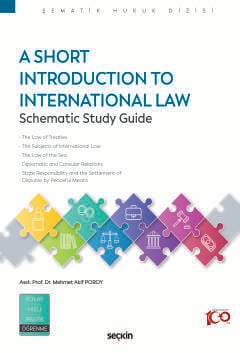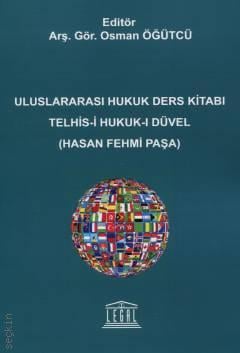
1. Baskı,
Ekim 2024
Kitabın Detayları
Dili:
İngilizce
Ebat:
19x27
Sayfa Sayısı:
136
Kitabın Fiyatı:
390,00₺
24 saat içerisinde temin edilir.
Kitabın Açıklaması
Discover the essential guide to international law with this new book designed for law students, students of international relations, and legal professionals alike. In today's demanding academic and professional environments, clarity and accessibility are paramount. This book meets this challenge head-on, presenting international law in a structured format enhanced with charts, schemes, and tables for efficient learning.
Crafted to address the urgent need for concise resources, this book distills complex topics into manageable insights. Whether you're diving into the foundations of international lawpreparing for exams, the author's clear and comprehensive approach supports your journey. Developed in response to feedback from students, practitioners, and enthusiasts, it offers a vital companion to traditional textbooks, aiding both initial understanding and rigorous review.
Ideal for those seeking to grasp the core principles without overwhelming detail, this book empowers you to navigate the complexities of international law confidently. Embrace a resource that enhances your understanding and enriches your academicprofessional pursuits. Discover the clarity and depth you need in international law.
Kitabın Konu Başlıkları

The Law of Treaties

The Subjects of International Law

The Law of the Sea

Diplomatic and Consular Relations

State Responsibility and The Settlement of Disputes by Peaceful Means
Kitapla İlgili Kategoriler
Kitabın İçindekileri
Contents
Preface
7
Table of Abbreviations
14
Chapter 1
THE NATURE AND DEFINITION OF INTERNATIONAL LAW
I. DEFINITION OF INTERNATIONAL LAW
15
A. Traditional Definition of International Law
15
B. Modern Definition of International Law
16
II. IS INTERNATIONAL LAW A TRUE LAW?
17
Chapter 2
SOURCES OF INTERNATIONAL LAW
I. THE SOURCES PROBLEM
21
II. PRIMARY SOURCES
22
A. Treaties
22
1. Definition of Treaties
22
2. Formation of Treaties
23
3. Authority to Negotiate, Draft and Sign a Treaty
23
4. Consent
24
4.1. Consent by Signature
25
4.2. Consent by Exchange of Instruments
25
4.3. Consent by Ratification
25
4.4. Consent by Accession
26
5. Reservations to Treaties
26
6. Entry into Force of Treaties
29
7. Treaty Interpretation
30
8. Successive Treaties
30
9. Invalidity of the Treaties
32
10. Termination and Suspension of Treaties
32
10.1. By Treaty ProvisionAgreement
33
10.2. Material Breach
33
10.3. Impossibility of Performance
33
10.4. Fundamental Change of Circumstances
33
B. Customary International Law
34
1. State Practice
34
2. Opinio Juris (Psychological Element)
35
C. General Principles of Law
35
III. SUBSIDIARY SOURCES
36
A. Judicial Decisions
36
B. Academic Writings
37
IV. UNILATERAL DECLARATIONS
37
Chapter 3
SUBJECT OF INTERNATIONAL LAW
I. STATES
39
A. d Qualifications
40
B. State Jurisdiction
41
C. The Territorial Principle
42
D. The Nationality Principle
42
II. INTERNATIONAL ORGANIZATIONS
43
A. Definition and Brief Explanation
43
B. The United Nations
45
1. The Key Objectives of the United Nations
45
2. The Organs of the United Nations
46
2.1. General Assembly
46
2.2. Security Council
46
2.3. International Court of Justice
47
2.4. Economic and Social Council
47
2.5. Trusteeship Council
47
2.6. Secretariat
48
III. INDIVIDUALS
48
Chapter 4
THE LAW OF THE SEA
I. MARITIME ZONES UNDER INTERNATIONAL LAW
49
A. Internal Waters
50
1. Normal Baseline
52
2. Straight Baselines
52
3. Mouths of Rivers
53
4. Bay Closing Lines
53
B. Territorial Sea
55
1. Definition
55
2. Innocent Passage
55
3. Jurisdiction Over Foreign Ships
57
3.1. Criminal Jurisdiction of the Coastal State
57
3.2. Civil Jurisdiction of the Coastal State
58
4. Delimitation of the Territorial Sea
59
C. Contiguous Zones
60
D. Exclusive Economic Zone
61
1. Rights and Duties of the Coastal State in the EEZ
61
2. Rights and Duties of Other States in the EEZ
63
E. Continental Shelf
63
1. The Rights and Duties of the Coastal State
63
2. Comparison of Rights and Duties Between the Continental Shelf and the EEZ
65
F. High Seas
65
1. The Freedoms of the High Seas
66
2. What is Flag State Jurisdiction?
66
3. Right of Hot Pursuit
66
II. THE AEGEAN MARITIME DISPUTES
67
A. The Delimitation of Territorial Sea Issue
68
B. The Delimitation of Continental Shelf Issue
70
C. Misuse of FIR Responsibility by Greece
73
III. THE TURKISH STRAITS
74
A. Merchant Ships
75
B. Warships
76
1. Passage Regime Through the Turkish Straits for Warships in Time of Peace
76
2. Passage Regime Through the Turkish Straits for Warships in Time of War When Türkiye is Not Belligerent
77
3. Passage Regime Through the Turkish Straits for Warships in Time of War When Türkiye is Belligerent
77
4. Passage Regime Through the Turkish Straits for Warships When Türkiye Considers Itself to be Threatened with Imminent Danger of War
77
Chapter 5
RECOGNITION
I. RECOGNITION OF STATES
79
A. Legal Effects of Recognition
79
1. Constitutive Theory
80
2. Declaratory Theory
80
B. Modes of Recognition
80
1. De facto Recognition
81
2. De Jure Recognition
81
3. The Distinction Between De Facto and De Jure Recognition
81
C. Forms of Recognition
82
1. Expressed Recognition
82
2. Implied Recognition
82
D. Withdrawal of Recognition
82
II. RECOGNITION OF GOVERNMENTS
82
Chapter 6
DIPLOMATIC AND CONSULAR RELATIONS
I. DIPLOMATIC RELATIONS
83
A. Inviolability of Missions
83
1. Premises
83
2. Archives, Documents and Official Correspondence
84
B. Immunities and privileges of Diplomatic Agents
85
1. Inviolability of Diplomatic Agents
85
2. Private Residence
85
3. Papers, Correspondence and Property
85
4. Personal Immunities from Local Jurisdiction
85
5. Witness Immunity
85
6. Exemption from Taxes
86
7. Exemption from Personal Services
86
8. Members of the Family of a Diplomatic Agent
86
C. Immunities and Privileges of Members of the Administrative and Technical Staff of the Mission
86
D. Immunities and Privileges of Members of the Service Staff of the Mission
86
E. Immunities and Privileges of Private Servants of Members of the Mission
87
F. Duration of Privileges and Immunities
87
G. Term of Office of the Diplomatic Agent
87
II. CONSULAR RELATIONS
87
A. Inviolability of the Consular Premises
88
B. Exemption from Taxation of Consular Premises
88
C. Inviolability of the Consular Archives and Documents
88
D. Inviolability of the Correspondence of the Consulate
88
E. Protection of Consular Officers
89
F. Personal Inviolability of Consular Officers
89
G. Immunity from Jurisdiction
89
H. Witness Immunity
89
İ. Exemptions
89
III. THE DIFFERENCES BETWEEN DIPLOMATIC AND CONSULAR IMMUNITIES AND PRIVILEGES
90
Chapter 7
STATE RESPONSIBILITY
I. ELEMENTS OF AN INTERNATIONALLY WRONGFUL ACT OF A STATE
91
II. CIRCUMSTANCES PRECLUDING WRONGFULNESS
94
III. REPARATION FOR THE INJURY CAUSED BY THE INTERNATIONALLY WRONGFUL ACT
94
IV. DIPLOMATIC PROTECTION
94
Chapter 8
THE SETTLEMENT OF DISPUTES BY PEACEFUL MEANS
I. DIPLOMATIC METHODS
98
A. Negotiation
98
B. Good Offices
98
C. Mediation
99
D. Conciliation
99
E. Inquiry & Fact–Finding
99
II. JUDICIAL SETTLEMENT
100
A. Arbitration
100
B. International Tribunal – The International Court of Justice (ICJ)
100
1. Composition of the ICJ
101
2. The Selection of the Fifteen Judges
101
3. The Registrar
102
4. Jurisdiction in Contentious Cases
103
5. Procedure
104
6. Enforcement of Judgments
104
7. Advisory Opinions
105
Chapter 9
SANCTIONS, COUNTERMEASURES, AND COLLECTIVE SECURITY
I. INADIMPLENTI NON EST ADIMPLENDUM (NON–PERFORMANCE EXCUSES NON–PERFORMANCE)
107
II. RETORSION
108
III. REPRISALS AND COUNTERMEASURES
108
IV. COLLECTIVE SECURITY
110
V. THE ROLE OF THE GENERAL ASSEMBLY (UNITING FOR PEACE)
112
Chapter 10
INTERNATIONAL CRIMINAL COURT
I. WHY WAS THE INTERNATIONAL CRIMINAL COURT ESTABLISHED?
113
II. WHAT IS THE INTERNATIONAL CRIMINAL COURT?
113
III. THE ORGANS OF THE ICC
115
A. The Presidency
115
B. The Chambers
116
1. The Pre–Trial Chamber
116
2. The Trial Chamber
116
3. The Appeal Chamber
117
C. The Office of the Prosecutor
117
D. The Registry
118
IV. CRIMES WITHIN THE JURISDICTION OF THE ICC
118
A. Genocide
118
B. Crimes Against Humanity
119
C. War Crimes
119
D. The Crime of Aggression
124
V. COURT PROCEEDINGS AND PROCEDURES
124
A. Initiation of Cases Before the Court
124
B. The Prosecutor’s Initiative to Open an Investigation
124
C. Process Upon Referral of a Situation to the ICC for Investigation
125
D. Warrant of ArrestSummons to Appear
125
E. Procedural Steps Following Issuance of ICC Warrant of Arrest
126
F. The Rights of the Suspect
127
G. Conduct of the Trial
127
H. Appeal and Revision
128
İ. Victims’ Participation
128
J. Protection of Victims Participating in Proceedings
129
K. Decisions Regarding Reparations for Victims at the Conclusion of a Trial
129
L. Witness Protection
130
Further Reading Recommendations
131
Index
133
Hakkımızda
|
Uluslararası Yayınevi Belgesi|
Kaynakça Dosyası|
Kişisel Verilerin Korunması |
Üyelik|
Siparişlerim|
İade Politikası|
İletişim


